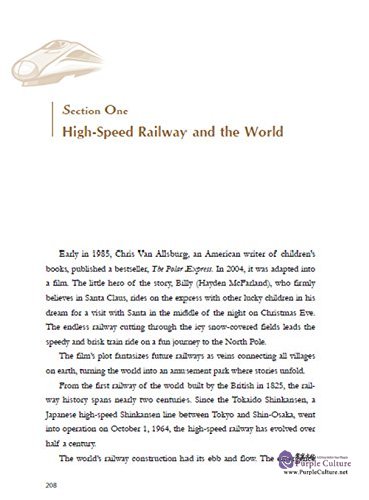Details
The rapidity of China’s high-speed railway development symbolizes the “China Speed” which is manifesting itself during the era of Reform and Opening Up.China’s high-speed railways are known for safety, convenience and comfort – the top choice for people on the move. With the “Four South-North” and “Four East-West” high-speed rail network taking shape in China, the zooming high-speed trains are changing the ways people work and live.The whole world has been amazed at the speed with which China has developed its railways. Even US President Obama once said, “There is no reason why Europe or China should have the fastest trains.” China is competitive worldwide in railway transportation infrastructure on the strength of its quality production capacity, advanced technology and delivery of value for money. The result is a brand-new calling card for Chinese manufacturing.As a witness to and participant in the development of high-speed railways in China, the author has extensively consulted archives, held in-depth interviews and gathered rare behind-the-scenes data to paint a vivid picture of how China has developed its high-speed railways. The record is one of a bittersweet journey, proving the superiority of the socialist system in its ability to pool forces to achieve something amazing. The new railways demonstrate the wisdom of the Chinese people. This book showcases the benefits HSR has brought to China’s overall development, as well as the bright prospects for the industry. The author’s fact-driven style and compelling narrative unveil the puzzles and challenges that accompanied the building of HSR in China, sharing unique stories both enlightening and invigorating.
Editor's Recommendation
An overview of the history of transportation reveals that, from the invention of the wheel some 6,000 years ago, through the birth of carriages some 4,000 years ago, to the penetration of automobiles, trains, steam boats and planes into people’s lives, means of transportation have been transforming mankind’s living space and life styles at an ever-accelerating pace. HSR (high-speed railway) is credited with lengthening people’s lives by enabling fast travel to save people’s time.
“China Speed” drives the progress of the times. “China Speed” is attracting more and more attention around the world, especially by means of the development of HSR in China. This country is the global leader in HSR bridges, tunnels and roadbeds, as well as track structure and EMU technology. On the whole, China boasts the cutting edge in the general design, construction, operation and technology of HSR, as measured by the five indicators of safety, reliability, applicability, cost-efficiency and advanced technology.
Currently, China is home to the HSR network with the longest operating mileage and biggest construction scale in the world. China is one of the global leaders in HSR technology, which has become a cultural icon showcasing “China Speed.” The country’s HSR also underpins “China Creation,” “China Intelligence,” “China Strength,” “China Pride” and “China Spirit.” China HSR is changing the landscape not only of China but of the whole world. HSR enable people to enjoy comfortable journeys around the world in a safe and convenient way.
About Author
Wang Xiong graduated from the Suzhou Railway Institute (predecessor of today’s Suzhou University of science and Technology). He began his writing career in 1989. Wang is a member of the Chinese Writers’ Association and vice-chairman of the Chinese Railway Writers’ Association. He has worked as a train driver, publicist and reporter. He currently works at People’s Rail magazine.
Wang has written novels, essays, non-fiction and academic papers. Many of his fiction works have been published in journals such as Selected Stories and Selected Novelettes. Representative works by Wang include the trilogy Yin/Yang Monument, The Time-honored Patina and The Jingui Silver Chamber. The second of these won the top prize in the Eighth Annual Chinese Railways Literature Awards. It was translated into English and published by the Foreign Languages Press.
Sample Pages Preview
Whether seen from the perspective of the Pan—Asian Railway or the third Eurasia HSR Corridor, China's Kunming is a central hub.This means the very end—the Yunnan Railways—of the entire China's railway network will have an opportunity to redefine its role in the future railway network and become a new hub of the "Belt and Road Initiative." Realizing this will extend our understanding of the Pan—Asia Railway.
Thetefore, the new "Silk Road" or "Ancient Tea—Horse Road" will become the portal of western China.Resources, including natural gas needed by China will be freed from the reliance of maritime importation,and the shipping time will be shortened.This Silk Road will offer a tremendous development opportunity in western China and greatly improve the transport format of culture, technology and goods between China and Eastern Europe.It is learned that countries along the route afe undergoing serious planning and launching research on the funding model, etc.
Speaking from the strategic landscape of Southeast Asia and China,countries with the closest ties with China are Brunei, the Plulippines and Malaysia.To China, the land route straight through Thailand connects the south and the north, and from there, the waterway can lead to the east and the west.Therefore, to China, Thailand's location holds strategic significance.
In fact, the China—Thailand Railway is a critical part of the Pan—Asian Railway.For Thailand, the Pan—Asian Railway will reduce the travel time to any of its reaches.Thailand has enough ports.However, the ports' capacity has been challenged to cope with the export volume.





